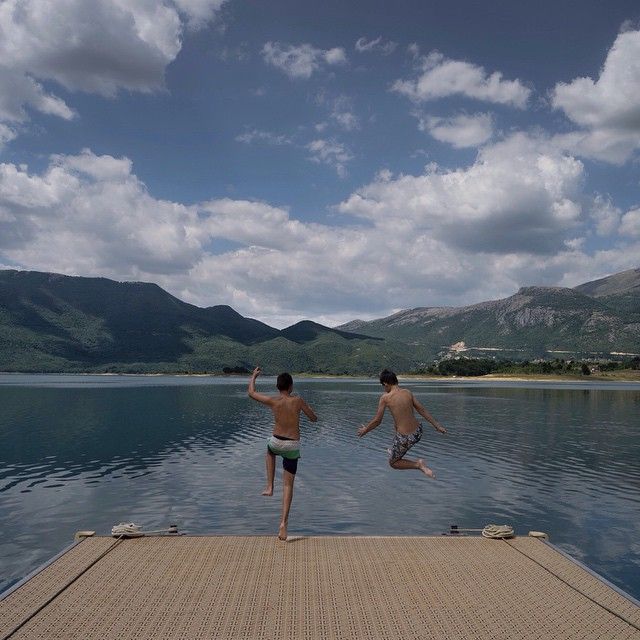In November, 1995, the Dayton Peace Agreement brought the Bosnian War to a halt by formally dividing up the country among the warring parties. Diplomats accorded about half the territory to the Bosnian Serbs, and the other half to the Bosniaks (Muslims) and the Bosnian Croats. According to the agreement, the parties controlling these two “entities”—Republika Srpska and the Federation of Bosnia and Herzegovina—would have to govern them together as one tenuous nation. In 1996, when the two sides were still reeling from war, NATO peacekeepers rimmed the border between them, which was a former frontline, and there was little civilian transportation crossing back and forth. Today, the internal frontier is largely invisible—you can see on a map that the boundary ripples along in a rough parallel to Bosnia’s border, scything out a partition, but there are no actual controls or customs in place; the verdant hills of the Bosnian terrain appear to rise endlessly before you in one continuous whole. And yet, the boundary still exists. While on a reporting trip in the country this summer, I needed to travel between two major cities in the north, Banja Luka and Tuzla, but was told that taking public transport between them was difficult, as they lie on opposite sides of the entity lines—the main bus company didn’t even cover the route, and there were a few smaller lines that went only late at night. It might even be easier to trace my way back five hours south to Sarajevo, the capital, and depart northward again from there.
It is at once the ingenuity and the irony of Ziyah Gafić’s photographs that they contain these invisible territorial boundaries—like Bosnia today, you can’t necessarily see the lines of partition in Gafić’s images until you pry into them a bit. One photo, from 2013, shows an imam in a long black robe standing meditatively against a wash of concrete in an empty depot, awaiting the arrival of coffins that contain newly discovered remains of victims from the 1995 genocide in Srebrenica. The image is deeply sorrowful, but it becomes even more chilling if you know that Srebrenica was largely “ethnically cleansed” of its Bosniak population, and today lies in the middle of the almost entirely Serb Republika Srpska. Bosniak residents who have chosen to return to the area face steep difficulties, from finding employment to seeing that their children are properly educated in schools that often seek to instill a one-sided understanding of history. Another of Gafić’s photos, from 2014, shows a seemingly unremarkable sheath of gaunt pines curving up a mountain above the russet roofs of Sarajevo. If you look closely, you can see that some of the trunks have branches sprouting only on one side: these trees run along what was, in the nineties, one of the most contested frontlines on Mount Trebević, where Bosnian Serb forces held siege over Sarajevo from above; the branches on the other side of the trees were spliced off by artillery fire and never grew back. They stand today as a sort of fossilized imprint of the battle lines.
“‘Dayton’ is at the same time one of the most celebrated and one of the most hated words in Bosnia,” Gafić told me. Celebrated, of course, because Dayton stopped the fighting and saved many lives. Yet it did so by giving in to the logic of the ethnic nationalism that had been used to incite violence, brokering a deal along ethnic lines that was intended as a peace agreement but has become, over two decades, a structure of governance. One Bosnian friend explained to me that Dayton had created such a weak foundation that the country couldn’t build anything on top of it; partly as a result, Bosnia today is very poor. She believed that there should have been another conference two or three years later to rectify what everyone knew was a problem from the outset. Gafić, who was born in Sarajevo in 1980, told me that he has been travelling around Bosnia to find out what the country looks like after “twenty years of the absence of war—not peace.” “Through sketches, I wanted to see where we are, if not as a nation then as a place,” he said.
When I recently interviewed the Bosnian novelist Aleksandar Hemon, I told him about a jarring experience I’d had in Banja Luka, the capital of Republika Srpska, when I travelled there on a reporting trip this summer. I had met a young, well-educated man about the same age as me—around thirty—who was a Serb. His view, which differed from most of the people I’d spent time with on my trip, was that ethnic identity would always be the most important factor in Bosnian politics, and that the idea of one cohesive country in the future was a fantasy. Hearing me recount this, Hemon told me that, unlike older Bosnians, who had spent half their lives as Yugoslavs, younger generations had had no such exposure to any larger political ideals. “Today it is impossible to establish in Bosnia a common utopian social project, as in, If we all work together this is what the society would be like,” Hemon said. Ethnic nationalists, he continued, “can only speak in terms of survival. There is no common societal project, and so there is no society.”
Still, it does a disservice to Gafić’s work to overlook the simple joy that emanates from many of his photos: two boys captured in midair as they cannonball into a lake in the middle of the mountains; a gutsy diving competition in the town of Konjic; a young girl snapping a selfie in Prijedor. These scenes of life carrying on, despite the recent history visited upon the country, convey a spirit of renewal, which draws some of its strength from the sublime beauty of the Bosnian landscape.
